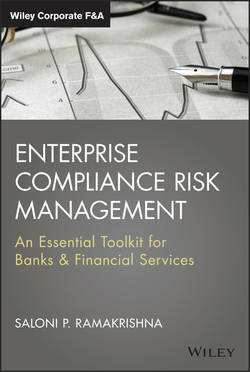Читать книгу Enterprise Compliance Risk Management - Ramakrishna Saloni - Страница 8
На сайте Литреса книга снята с продажи.
Opening Notes
ОглавлениеWhen I first thought of writing a book, the advice from a friend (an author himself) was “Don't do it!!” Don't do it: It is not as romantic as it appears; it is too demanding; you are on your own, plodding through thousands of pages that take you off on a tangent. New ideas fight to find expression only to have most of your writing and rewriting edited later. Days get longer and slip from your hands while fighting deadlines. You will become a recluse as all your time is occupied with digesting the mountain of information and plethora of thoughts. Don't do it if you think there is money or fame in it – there may not be. Don't do it, except if the subject interests you and you are excited about sharing it with others. Thanks, Chris Marshall, for that sane advice!
Flowing from that advice, I chose compliance risk management, a young, evolving, layered, and intricate discipline. As a hands-on practitioner in the financial services industry for almost three decades, I have interacted with different stakeholders – seniors from banks and financial institutions, regulators, business consulting, technology providers and industry bodies – and have garnered a distinct canvas of knowledge in the compliance field that needs to be shared through a credible medium (and, thus, this book). I truly believe that done right, active and positive compliance is a value multiplier for business. The content is a blend of the body of knowledge gained through first-hand experience and wisdom from industry participants though interactions with relevant stakeholders, which gives it a distinct real-world perspective.
Demystifying a subject like compliance risk management, a fabric with many hues, at once an art, a craft, and a science, was demanding to say the least. The task was challenging and therefore creatively stimulating. The attempt is to go beyond evangelizing the relevance of compliance to bring real-world experiences in the arena of banking and financial services and to capture the changing contours of the subject as well as draw out compliance risk as a distinct risk discipline, thus enriching the dialogue and contributing to the healthy growth of this young and dynamic subject.
The narrative is shaped by the distinct influences of two of my mentors, the first one taught me that “all fundamentals are simple and straightforward and do not need the garb of jargon to claim their rightful place. You resort to jargon when you want to camouflage the fact that you are not clear.” The mantra of the second mentor was “Elevate the debate, energize the dialogue, and go from what it is to what it can be. That is how growth and progress happens.” The tone of the book, therefore, is simple and straightforward. The attempt is to elevate the context of compliance from its current reactive stance to how a proactive strategy can create a clear differentiator in a largely undifferentiated market and become a powerful competitive weapon for the organization.
The main theme underlying the book is that it pays to responsibly grow business by enhancing stakeholder value. It encapsulates the following subthemes:
• Integrity at the core of responsible business
• The distinction between business and “healthy” business
• “Win-Win” approach for all stakeholders as the secret for sustainable growth
• Active compliance management as “strategic tool” in value creation, preservation, and enhancement
This book contains relevant information for all of the stakeholders of the financial services industry.
